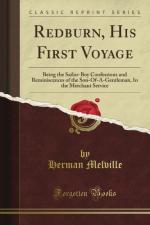|
This section contains 12,212 words (approx. 41 pages at 300 words per page) |

|
SOURCE: Robillard, Douglas. “Redburn: ‘Mythological Oil-Paintings.’” In Melville and the Visual Arts: Ionian Form, Venetian Tint, pp. 47-69. Kent, Ohio: The Kent State University Press, 1997.
In the following excerpt, Robillard discusses Melville's linking of landscape and seascape descriptions with works of art through his character/narrator Wellingborough Redburn, who envisions the entire world as a work of art.
After his juvenile, unsuccessful efforts at ekphrasis in the “Fragments from a Writing Desk,” Melville did not attempt to use this literary technique for the next ten years. For a substantial part of that time, he was working as a school-teacher, a “boy” on a merchant ship, and a sailor aboard whalers and naval vessels. Returning to shore in 1845, he began immediately to convert some of his experiences into imaginative novels that had a firm basis in fact. Typee (1846), Omoo (1847), and Mardi (1849) all used the conventional novelistic device of scenic...
|
This section contains 12,212 words (approx. 41 pages at 300 words per page) |

|


